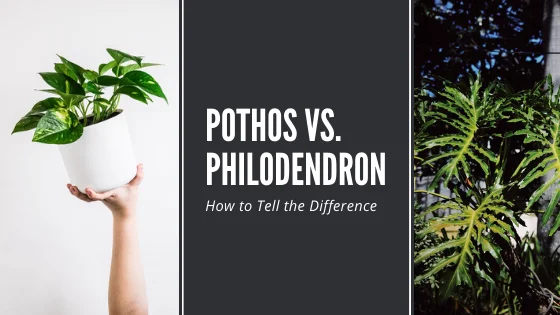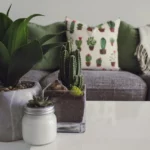While being among the most popular houseplants, pothos and philodendron varieties look alike and share growth habits and requirements. However, it’s worth noting that they are entirely different plants with distinct needs and characteristics.
Once you know the exact features to look for, it’s easier to distinguish these plants from the other.
Table of Contents
Key Differences Between the Two Houseplants
Several identifiable features and characteristics can help you tell pothos and philodendrons apart. These attributes include their petiole, sheath, leaf shape and texture, aerial roots, and taxonomy. Peep each one of them below:
Taxonomy
Taxonomy is a distinct branch of science that focuses on classifying groups of natural organisms. It also helps name and organizes plants into families and genera. Since they are different plants, pothos and philodendrons fall into separate genera.
Philodendron is part of the Philodendron genus, while pothos is part of the Epipremnum genus. The two plants belong to a plant family known as Araceae.
Size and Shape of the Roots
The roots on both pothos and philodendrons can also help you tell them apart. Pothos has broader and stubbier aerial roots.
Philodendrons, on the other hand, have thinner aerial roots. Though these roots have structural differences, they play similar roles.
Leaf Texture and Shape
Pothos have thicker, larger, and waxier leaves, while philodendrons have soft, thin heart-shaped leaves. The leaf base on the pothos plant is relatively straight.
Philodendrons have a leaf base that curves inwards and takes the shape of the top part of a heart.
Petiole
Since it connects the leaf to the vine, the petiole is an easy to identify feature on plants. Pothos have indenting petioles, which form two brown and papery edges. Philodendrons, on the other hand, have round and uniform petioles.
Sheath
As they grow, philodendrons form sheaths from their nodes, just like many houseplants. The node, in this case, is the region where the petiole and leaf meet the vine. These sheaths turn brown and papery with time. Unlike philodendrons, pothos doesn’t have sheaths.
Growing Differences
Both pothos and philodendrons require the same growing conditions (temperature, water, soil, and light) to survive and thrive. They are the lowest maintenance houseplants you can ever get. However, they also have various growing differences that you should know,
Though pothos and philodendrons can thrive in low light settings, pothos is more adaptable to this condition. Philodendrons get weaker and may grow tiny leaves if they fail to get enough light.
Pothos may get weaker when denied adequate light, but their leaf size will remain the same. You can easily propagate pothos by cuttings since they have a higher tolerance to drought, unlike philodendrons.
Growth Habit
You can tell pothos and philodendrons apart by checking whether they have cataphylls on them. Cataphylls are tiny leaves that surround and protect new leaves as they grow.
They tend to remain on the plant once the new leaf unfurls and dry up and fall off with time. As a new leaf grows on a vining philodendron, it emerges from a cataphyll.
Pothos grow new leaves differently when compared to philodendrons. Their leaves grow and unfurl from previous leaves instead of relying on cataphylls. Old leaves will eventually dry up and fall off as the plant continues to sprout.
Types of Pothos and Philodendron
Pothos and philodendrons have several varieties that look very different. It’s important to know these varieties by name and structural qualities when shopping for a houseplant. Here’s everything you should know about them:
Pothos Varieties
All pothos varieties have heart-shaped leaves and long trailing stems. They are also easy to grow indoors and require minimal maintenance.
The most common plants that fall into the Epipremnum aureum (the scientific name of pothos) include marble queen pothos and neon pothos. Other varieties include pearl and jade pothos and Golden pothos.
One distinguishing feature between these varieties is the leaf variegation. Their leaves may be white, lime, bright lemon, or dark in color. They thrive in bright, indirect light, and well-drained moist potting soil.
Keep the temperatures between 65 degrees Fahrenheit and 85 degrees Fahrenheit and the humidity levels relatively high for ample growth.
Pothos varieties grow well in hanging baskets or pots. They may have leathery or glossy leaves, depending on the type. It’s important to water them when the soil is partially dry and prune their stems for a bushier look. Apply fertilizer every month during the growing season.
Philodendron Varieties
Philodendron varieties are among the fastest-growing, low maintenance, and easy to grow houseplants. You can buy most of these plants from local stores, though some types are challenging to find.
Out of the 450 plus varieties of the philodendron plants, the common ones include the philodendron gloriosum, philodendron grazielae, and philodendron erubescenes (Pink Princess).
Others include philodendron bipinnatifidum, philodendron White knight, philodendron Brazil and philodendron moonlight.
The philodendron gloriosum variety has large, deep green leaves and white veins, while the philodendron grazielae boasts shiny, heart-shaped leaves. The grazielae variety grows slower than other varieties, it requires more maintenance and support to thrive.
Pink Princess features dark green leaves with splashes of red and bright pink. It is also more fragile than other varieties and requires a lot of light to maintain its colors.
Philodendron bipinnatifidum sports split leaves and grow a bit slower. You can use this houseplant to make a bold statement in your rooms.
The White knight variety features dark green leaves with bold blocks of green or white and purple stems. It can beautifully climb a trellis and boasts variegated leaves.
If you are looking for a philodendron variety that is easy to grow, consider philodendron Brazil. This houseplant boasts heart-shaped green leaves with splashes of lime green or yellow streaks. It requires a lot of bright, indirect light, just like the other varieties, for maximum growth.
The Bottom Line
We hope that this guide gives you a better understanding of pothos and philodendron varieties. You can now decide on which variety you want to propagate or grow indoors.
Both pothos and philodendrons can improve the appeal of your rooms and add a natural feel to spaces. They are also easy to propagate and maintain.
Photo by Nothing Ahead from Pexels
Photo by Severin Candrian on Unsplash



